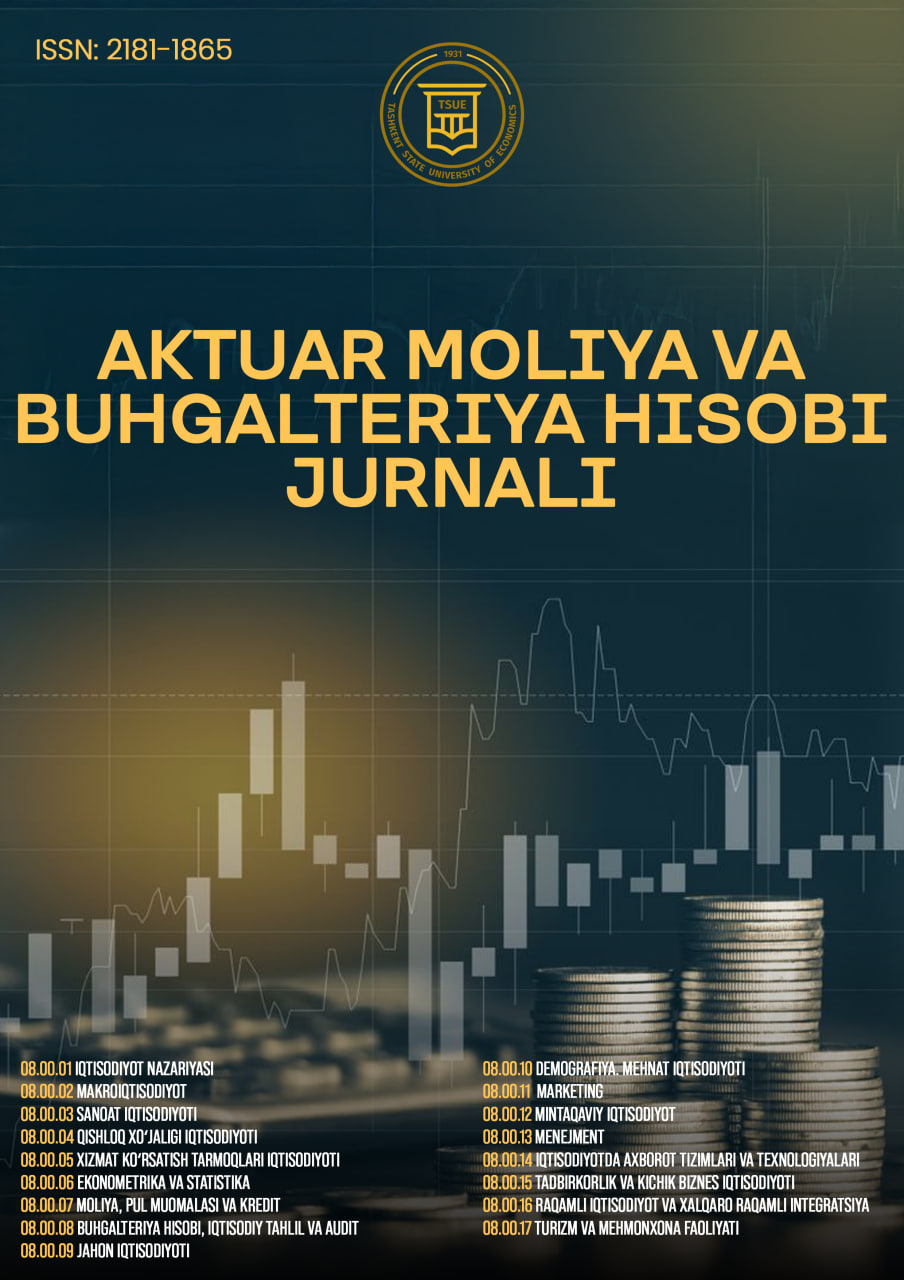YASHIRIN IQTISODIYOTNI O‘LCHASH AMALIYOTI USULLARI NAZARIY ASOSLARI
Keywords:
Abstract
Ushbu maqolada "yashirin iqtisodiyot" mazmuni, turlari, mexanizmlari, tarmoqlari va uni quritish sohalari yoritilgan. Yashirin iqtisodiyotni o‘lchashning asosiy muammolari va ushbu muammolarni bartaraf etish yo‘llari keltirilgan. Shuningdek, yashirin iqtisodiyotni o‘lchash usullarini takomillashtirish bo‘yicha ilmiy taklif va amaliy tavsiyalar berilgan.
References
Yeliseeva I.I., Burova N.V. Nauchnыe trudы RESEP «Podxod k izmereniyu tenevoy ekonomiki v regionax». – M., 2014. -328s.
Metodologicheskie prinsipы otrajeniya v SNS tenevoy ekonomiki i metodicheskie rekomendatsii po raschetu otdelnыx yee pokazateley. – M.: Statisticheskiy komitet sodrujestva nezavisimыx gosudarstv (statkomitet SNG),2019 – 234s.
Schneider F., Buehn A., Montenegro C.E. Shadow Economies All over the World: New Estimates for 162 Countries from 2010 to 2019. World Bank, Policy Research Working Paper Series, 2021, no. 5356, pp. 1–54. URL: http://urlid.ru/af3q
Lubell H. The Informal Economy in the 1980s and 1990s. Development Centre of the Organization of Economic Co-operation and Development, Paris, 1991, 128 p.
Smith P.M. Assessing the Size of the Underground Economy: The Statistics Canada Perspective. In: Lippert O., Walker M. (Eds). The Underground Economy: Global Evidence of Its Size and Impact. Vancouver, The Fraser Institute, 1997, pp. 11–36.
Williams C.C. Evaluating the Magnitude of the Shadow Economy: A Direct Survey Approach. Journal of Economic Studies, 2006, vol. 33, iss. 5, pp. 369–385.
Feige E.L. A Re-Examination of the 'Underground Economy' in the United States: A Comment on Tanzi. IMF Staff Papers, 1986, vol. 33, no. 4, pp. 768–781. URL:http://econwpa.repec.org/eps/mac/papers/0501/0501021.pdf.
Schneider F., Buehn A., Montenegro C.E. Shadow Economies All over the World: New Estimates for 162 Countries from 1999 to 2007. World Bank, Policy Research Working Paper Series, 2010, no. 5356, pp. 1–54. URL: http://urlid.ru/af3q.
Quintano C., Mazzocchi P. The Shadow Economy beyond European Public Governance. Economic Systems, 2013, vol. 37, no. 4, pp. 650–670. URL: http://isiarticles.com/bundles/Article/pre/pdf/47817.pdf.
Schneider F., Savasan F. DYMIMIC Estimates of the Size of Shadow Economies of Turkey and of Her Neighboring Countries. International Research Journal of Finance and Economics, 2007, iss. 9, pp. 126–143.
Orsi R., Raggi D., Turino F. Size, Trend, and Policy Implications of the Underground Economy. Review of Economic Dynamics, 2014, vol. 17, iss. 3, pp. 417–436. URL: https://ideas.repec.org/a/red/issued/12-217.html.
Gomis-Porqueras P., Peralta-Alva A., Waller C.J. Quantifying the Shadow Economy: Measurement with Theory. Federal Reserve Bank of St. Louis, Working Paper Series, 2011, no. 2011-015A, pp. 1–32. URL: https://research.stlouisfed.org/wp/2011/2011-015.pdf
Birinci S., Elgin C. Shadow economy over the business cycle: how do formal and informal cycles interact? Unpublished manuscript, 2013. 24 p.
O'Higgins M. Assessing the Underground Economy in the United Kingdom. In: Feige E.L. (Ed.). The Underground Economies: Tax Evasion and Information Distortion. Cambridge, Cambridge University Press, 1989, pp. 175–195.
Bhattacharyya D.K. An Econometric Method of Estimating the 'Underground Economy'. United Kingdom (1960–1984): Estimates and Tests. Economic Journal, 1990, vol. 100, no. 402, pp. 703–717.
Dell'Anno R., Halicioglu F. An ARDL Model of Unrecorded and Recorded Economies in Turkey. Journal of Economic Studies, 2010, vol. 37, iss. 6, pp. 627–646.
Feige E.L. Currency Velocity and Cash Payments in the U.S. Economy: The Currency Enigma. MPRA Paper, 1989, no. 13807, pp. 1–40.
Lyssiotou P., Pashardes P., Stengos T. Estimates of the Black Economy Based on Consumer Demand Approaches. The Economic Journal, 2004, vol. 114, iss. 497, pp. 622–640
Feinstein J.S. Approaches for Estimating Noncompliance: Examples from Federal Taxation in the United States. The Economic Journal, 1999, vol. 109, iss. 456, pp. 360–369.
Calzaroni M. The Exhaustiveness of Production Estimates: New Concepts and Methodologies. Proceedings of the International Conference on Establishment Surveys, Buffalo, USA, 2000, pp. 1–10. URL: http://oecd.org/std/na/2464056.pdf.
Nastav B., Bojnec S. The Shadow Economy in Bosnia and Herzegovina, Croatia, and Slovenia: The labor approach. Eastern European Economics, 2007, vol. 45, iss. 1, pp. 29–58. URL: http://urlid.ru/af3w
Draeseke R., Giles D.E.A. A Fuzzy Logic Approach to Modelling the New Zealand Underground Economy. Mathematics and Computers in Simulation, 2002, vol. 59, iss.1-3,pp.115–123.URL: http://www.sciencedirect.com/science/article/pii/S0378475401003998.
Ene C.-M., Hurduc N. A Fuzzy Model to Estimate Romanian Underground Economy. Internal Auditing and Risk Management, 2010, vol. 2, iss. 18. URL: http://aimr.univath.ro/archive/atharticles/2010-2/2010-2-2.pdf
Maršić K., Oreški D. Modelling the Size of Underground Economy in Croatia: Fuzzy Logic Approach. Central European Conference on Information and Intelligent Systems, Varaždin, Croatia, 2014, pp. 70–77. URL: http://www.ceciis.foi.hr/app/public/conferences/1/papers2014/685.pdf


